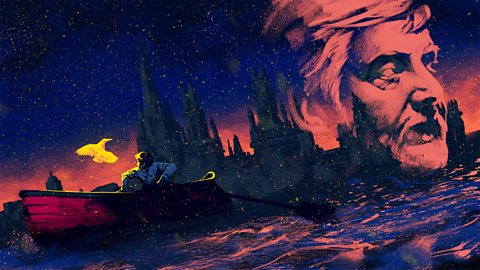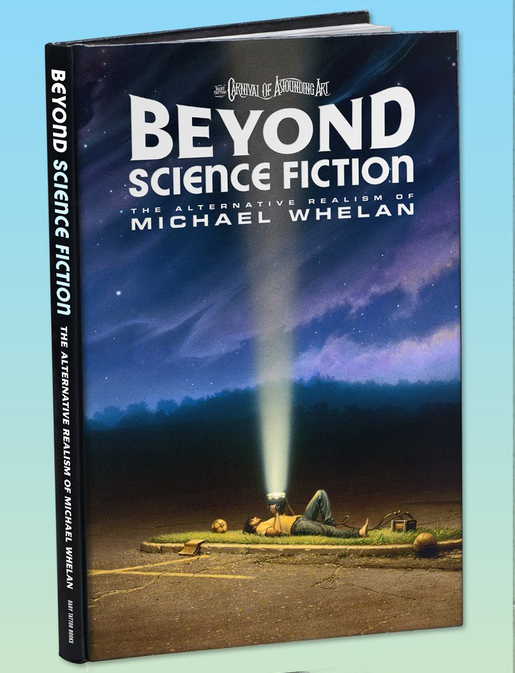(1) WELCH’S STAR WARS VINTAGES. Collect and swill ’em all!
The Force is strong with these ones! Welch’s new Star Wars™ themed Sparkling Red 100% Grape Juice is the perfect addition to your celebration, or to your collection. Find all 4 unique designs, including the limited edition!
(2) PULLMAN ON THE AIR. Starting next Monday, BBC Radio 4 is presenting a 10-part audio narration of Philip Pullman’s La Belle Sauvage, volume 1 of Pullman’s new The Book of Dust trilogy.
Episode 1 at 10:45 PM (GMT), Monday 10/23. As usual with BBC, the episodes will be available for online listening “shortly after broadcast”.
This is part of BBC’s Book At Bedtime series, which is more of an audiobook-on-radio than the dramatic adaptations they’ve done elsewhere on their schedule.
Accompanying the novel installments will be nonfiction essays by Pullman, “Dreaming of Spires”:
In these personal, entertaining and deeply thoughtful essays, Philip Pullman examines the art of storytelling.
Written over a period of 30 years, they reflect on a wide range of topics including the origins of his own stories, the practice of writing and the storytellers who have most inspired him.
(3) FORMERLY FORBIDDEN. Cat Rambo conducts an “Interview with Sherwood Smith on Omniscient Point of View in the Inda Series”.
Recently the question of omniscient POV has come up in several classes, so I started reading some examples of it. One of the best I hit was Sherwood Smith’s Inda series. I figured, why not go to Sherwood and ask some questions about how she pulled that off.
What drew you to using omniscient point of view for the Inda series? What sorts of stories work particularly well with that POV? Were there any models that you looked when working with it?
I had always written in omni. I’m a visual writer (with all its pluses and pitfalls), which means I see a movie in my head—not just dialogue but characters’ inner lives. Omni always seemed the easiest way to get that movie down.
But when I started selling, I was told to switch to limited third, which I had to learn.
Segue up a couple decades, I was desperate to escape the limitations of third, and omni was no longer (trigger doom music) Forbidden….
(4) BECKY CHAMBERS’ NEXT NOVEL. Hodderscape invites you to “Read the first extract from Becky Chamber’s Record of A Spaceborn Few“
When we heard that Becky Chambers was writing a new book set in the world of the Wayfarers we were over the moon. When we read the blurb and heard that one of the main characters was an alien academic (squee!) we were way over the moon and somewhere near Jupiter. Then we read this extract and we shot into a whole other galaxy entirely.
…Record of a Spaceborn Few arrives 26th July 2018 and is available to pre-order now.
(5) FILERS AND REFILERS. Librarians at an Auckland public library kept finding books that had gone missing from their shelves “reshelved” in nooks & crannies. Turns out bookloving homeless people were responsible (because they didn’t want the books to be lent out before they got a chance to finish reading). The New Zealand Herald has the story: “The curious case of the missing books at Auckland Library”.
“A lot of the guys that come in are extremely well-read and have some quite eccentric and high-brow literary tastes … people are homeless for so many different reasons, and being intelligent and interested in literature doesn’t preclude that.”
According to Rivera, around 50 homeless people visit the library daily.
The story also has been taken up by The Guardian.
(6) FOR YOUR SJW CREDENTIAL. Cat bowls hand-painted by celebrities are being auctioned for the benefit of “Architects For Animals Giving Shelter”. They include the handiwork of William Shatner, Elvira, and Jeri Ryan.
(7) HOVERCRAFTER. IBM’s Science and Star Wars video series talks about how superconductors are the future of mass transportation – an installment featuring Kevin Roche, engineer scientist at IBM Research Almaden who coincidentally is also chair of next year’s Worldcon in San Jose.
(8) EATING THE FANTASTIC. Episode Five-Oh! Book ‘em, Danno! Scott Edelman invites everyone to “Bask in Basque beef stew as Eating the Fantastic turns 50 with guest Xia Jia”.
Here we we are, more than 20 months later, and those of you who’ve followed my journey have listened as I’ve shared at times full meals—at times a donut, during my two lightning–round episodes—with more than 75 guests. And the feasting’s not over yet!
This time around, I’m inviting you to join me and my guest for lunch during Worldcon at Parrilla Española, the oldest Spanish restaurant in Helsinki.
And who is this episode’s guest?
Xia Jia, whose short stories have been published in Nature, Clarkesworld, Year’s Best SF, Science Fiction World, and many other venues. She’s won five Galaxy Awards for Chinese Science Fiction as well as six Nebula Awards for Science Fiction and Fantasy in Chinese. But her science fiction skills have been visible on more than just the page, because she directed the 2007 science fiction film Parapax, in which she also acted, appearing as three different identities of the protagonist across parallel universes.
We discussed how reading science fiction gave her the courage to take risks; what it means when she says she writes not hard SF, nor soft SF, nor slipstream, nor cyberpunk, but “porridge sci-fi;” why Ray Bradbury matters so much to her; the challenges of writing in Chinese, writing in English, and translating from one language to the other; our mutual love for Italo Calvino’s If on a Winter’s Night a Traveler; how The Three-Body Problem changed the perceptions of science fiction in China, why she has faith she’ll eventually get to Mars, and more.
(9) MAY OBIT. Julian May (1931-2017) died October 17.
John Hertz profiled her in “May the Force Be With Her” in 2015, after he accepted her First Fandom Hall of Fame Award on her behalf.
She has always spelled her name Julian, and although after marrying T.E. Dikty (1920-1991, elected posthumously in 2013) she sometimes declared copyright as Julian May Dikty, she continued to write under the name Julian May — among others, including, I’m told, Wolfgang Amadeus Futslogg, by which I dare not address her.
Her fanzine was Interim Newsletter, rendering her to some extent a surrogate for all of us. Her story “Dune Roller” was in the December 1951 issue of Campbell’s Astounding, with four interiors by herself (it was made into a 1972 film, credited to her as Judy Dikty). Eight months later she chaired Chicon II, at the age of twenty-one….
(10) TODAY IN HISTORY
- October 20, 1932 — James Whale’s The Old Dark House opens in theaters.
- October 20, 1943 – Son of Dracula premieres.
(11) TODAY’S BIRTHDAY BOY
- October 20, 1882 – Bela Lugosi
(12) COMICS SECTION.
John King Tarpinian believes in Frankensteinly speaking as practiced by The Argyle Sweater.
(13) SPEAK UP. Mary Robinette Kowal is boosting the signal.
Hey Authors. Did you know that if your audiobook is produced by ListenUp, they don't pay fair rates? #listenupListenup pic.twitter.com/uWIxUGGbkW
— Mary Robinette Kowal (@MaryRobinette) October 20, 2017
(14) SOUND INVESTMENT. Atlas Obscura takes us “Inside the World of a Halloween Sound-Effects Artist”.
…Jumping ahead to the late 1950s, vinyl records allowed people to bring albums of sound effects home. Novelty records by the likes of Spike Jones, featuring funny monster songs and spooky stories set to eerie effects, became popular. However, possibly the first record with a track of just spooky sounds seems to be a record released by Disney in 1964 called Chilling, Thrilling Sounds of the Haunted House. The album features effects that are now Halloween staples: moaning ghosts, barking dogs, clattering chains, and screaming victims, interspersed with short, often comedic, vocal segments that established them. “Disney’s Haunted House album, which was rereleased in 1995, seems to have become a staple in the U.S.A. in particular,” Haggerwood says.
(15) ANOTHER WORLD. At Nerds of a Feather, The G kicks off a new series of posts: “WORLDBUILDING: A Big World and Beyond”.
Welcome to the first post in our Worldbuilding series, where our writers explore various elements of imagining place, people and culture. Today I’m going to discuss where inspiration for fantasy worlds comes from, and what I’d like to read more of in that regard. Obligatory disclaimer: this is an opinion piece. You may agree, if our tastes align or if the arguments put forth resonate with you; or you may disagree, if they do not. That’s healthy. There is ample space for all kinds of approaches to fantasy, and life would be boring if we all wanted to read the same things. -G
Second-world fantasy is not historical, but draws from human histories, cultures and mythologies. The most famous and influential fantasy author, J.R.R. Tolkien, drew heavily from Nordic and Celtic mythologies in constructing Middle Earth. Most fantasy published since The Lord of the Rings has been similarly Eurocentric, utilizing the tropes he established and/or popularized as well as other widely-known (European) sources: Arthurian Legends, the Brothers Grimm, Niebelungenlied and various medieval bestiaries. Many, like Tolkien, are also in a sense a retelling of Song of Roland, or Herodatus–wherein a “civilized” stand-in for the West is threatened by a horde from the geographic periphery.
(16) TASTER’S CHOICE. Also at Nerds of a Feather, Charles Payseur uploads his monthly short fiction reviews: “THE MONTHLY ROUND – A Taster’s Guide to Speculative Short Fiction, 09/2017”.
The stories very much run the gamut between joyous and crushing, but each one is beautiful in its own way, and each brings its unique flavor to this early autumn tasting experience. So settle in and raise a glass, and let’s get to it. Cheers!
Tasting Flight – September 2017
“Pan-Humanism: Hope and Pragmatics” by Jess Barber and Sara Saab (Clarkesworld)
Notes: Expertly balanced between darkness and light, the story tastes like a breath of fresh air after a lifetime of smog, warms and lifts and offers a hope of healing.
Pairs with: Amber Bock
Review: Amir and Mani grow up in a Beirut strained by climate change, by water-scarcity, by the fear of doing greater harm. Both characters, because of their world and because of the weight of history, know only too well the cost of possession, of privatization. Both enter into service to try and heal the planet and bring water and hope and life back to a world that is on the brink. At the same time, they find themselves drawn to one another, and yet mindful that how humans treat the world, and how they treat each other, is linked, and that treating people like possessions, just like treating the Earth like a possession, leads only to corruption, deprivation, and loss. The story, through the exploration of these characters lives and relationships, begins to build a picture of what it might take to make the world work better. It stresses that it’s not technology alone that will save us, because without a philosophy to match, the exploitation and consumption will continue to escalate, pushing past all obstacles and barriers and safeguards. I love how the story implies that humanity needs a different framework in order to respect humans and the environment, in order to put cooperation and compassion ahead of personal ambition or passion. And it is a beautiful story that touches on how love still works in this philosophy, not quite in the same way that we now expect but still in profound and powerful dimensions that allow Amir and Mani’s story to be one of hope and healing and triumph, even as it is often about longing and distance as well. It is an amazing piece, and one of my very favorite stories of the year, period.
(17) WHERE NO MAN HAS GONE. At Centauri Dreams, an interesting piece on whether robotics might make the traditional SF vision of asteroid mining practical — “Robotic Asteroid Mining: Bootstrapping the Solar System Economy”.
While the prospects for humans in space dimmed somewhat, a renewed flowering of developments in AI and robotics burst onto the scene with capabilities that astonished us each year. On the endlessly orbiting ISS, while astronauts entertained us with tricks that we have seen since the dawn of spaceflight, autonomous robots improved by leaps and bounds. Within a decade of a DARPA road challenge, driverless cars that could best most human drivers for safety appeared on the roads. Dextrous robots replaced humans in factories in a wide variety of industries and threaten to dramatically displace human workers. DeepMind’s AlphaGo AI beat the world’s champion GO player with moves described as “beautiful” and well within the predicted time frames. In space, robotic craft have visited every planet in the solar system and smart rovers are crawling over the face of Mars. A private robot may soon be on the Moon. In orbit, swarms of small satellites, packing more compute power than a 1990 vintage Cray supercomputer, are monitoring the Earth with imaging technologies that equal those of some large government satellites. On Earth we have seen the birth of additive manufacturing, AKA 3D printing, promising to put individual crafting of objects in the hands of everyone.
What this portends is an intelligent, machine-based economy in space. Machines able to operate where humans cannot easily go, are ideally suited to operating there. Increasingly lightweight and capable, and heedless of life support systems, robotic missions are much cheaper.. How long before the balance tips overwhelmingly in the machines’ favor? Operating autonomously, advanced machines might rapidly transform the solar system.
(18) FASHION VIOLATIONS. Kelly Woo’s Yahoo! piece, “Halloween horror: 19 terrible ‘sexy’ movie and TV costumes no one should ever wear”, is clickbait that warns that women who want to dress up as Sexy Freddy Kruger, Sexy Strawberry Shortcake, and Sexy Remote Control, don’t do it!
So-called sexy Halloween costumes have gotten out of control in the last few years, with manufacturers doing their best to crank out a “sexy” version of pretty much anything. Even characters that have no business being sexy are now tarted up — and it’s time for the madness to end. Click through to see 19 terrible “sexy” pop culture costumes that simply should not exist.
(19) KEEPS ON TICKING. Lisa Taylor is enthusiastic about The Salt Line by Holly Goddard Jones — review at The Speculative Herald.
I’ll cut straight to it: The Salt Line is one of my favorites for the year. The entire concept of killer ticks sounds like it could be campy or over the top. That is not at all the case. The ticks are described in such a realistic and terrifying way that it truly becomes plausible. Or at least feels plausible. The author is able to use enough facts grounded in science to create this terrifying epidemic. This book did remind me a bit of Joe Hill’s The Fireman in that way. It depicts a world that has been ravaged by some disease, where people’s ways of life are altered because of them. I suppose there are a number of books that could fit this, but the over all tone and presentation and just the quality of writing put me in mind of Hill. That is a huge compliment from me as Hill is one of my favorite, must read authors.
(20) IT IS THE END, MY FRIEND. Talk about “news to me” – I never heard there was another ending: “Frank Oz restores dark original ending of ‘Little Shop of Horrors’ for Trump era”.
The first time Warner Bros. screened Little Shop of Horrors, Frank Oz’s 1986 film musical, test audiences ate it up like a bloodthirsty plant devouring a sadistic dentist. They rooted hard for Seymour (Rick Moranis), the nerdy 1960s shop assistant who makes a devil’s bargain with a man-eating plant to win the love of his co-worker Audrey (Ellen Greene). Every scene met with laughter and applause — until the plant devoured Seymour and Audrey, and the audience went silent. After two previews and many livid comment cards, Oz and screenwriter Howard Ashman decided to scrap the original, 23-minute ending — in which the plant eats everyone and takes over the world — in favor of giving Seymour and Audrey their happily-ever-after. Oz has no regrets. “My job is to entertain,” he tells Yahoo Entertainment, and the new ending was “more satisfying to the audience.” However, film fans have long mourned the disappearance of the original ending, which included a heartbreaking reprise of Audrey’s ballad “Somewhere That’s Green” and a fantastic montage of the plant, named Audrey II, rampaging, Godzilla-style, across New York City.
This month, Little Shop of Horrors will be screened for the first time nationwide with its original, darker ending restored. Oz wonders if the film will have a new resonance in the Trump era, when America’s real-life monsters thrive on blood, greed, and the misguided good intentions of countless Seymours….
(21) THE KINDEST CUT OF ALL. Vanity Fair interviews the principals to find out “How The Princess Bride Built Film’s Most Beloved Sword Fight”.
For six months, Princess Bride star Mandy Patinkin had trained to become Inigo Montoya, the world’s greatest swordsman. His worthy opponent, the Man in Black/Westley—played by Cary Elwes—had four months of prep under his belt as well. Spirits were high as the actors performed their duel for director Rob Reiner on the Cliffs of Insanity set for the first time, in London in 1986.
Elwes and Patinkin finished, drawing applause from the film’s crew. Then, both drenched in sweat, they looked to Reiner, who voiced his own response: “That’s it?” It wasn’t exactly the reaction they had hoped for.
(22) THE PEN IS MIGHTIER. Marked down to $6,862.50! “Montegrappa Limited The Iron Throne Game Of Thrones Limited Edition Fountain Pen & Rollerball Set Matching Number”.
But if you can’t swing that, there’s always “Montegrappa Limited DC Comics Superhero Set Ballpoint” for $3,920.00.
(23) SPACE JOCKEY. Jockey statues have mostly gone out of fashion – unless it’s one created by H.R. Giger. You’ve got less than a week to put in your bid at Nate Sanders Auctions: “H.R. Giger Hand-Painted Model of Space Jockey & the Derelict Spaceship From ”Alien” — Measures Over 3 Feet by 3 Feet, Personally Owned by 20th Century Fox Executive Peter Beale”. Minimum bid: $100,000.
The enormous Space Jockey and cavernous spaceship are quintessential Giger, renowned for human-machine melded beings called biomechanoids; the walls of the spaceship appear to be either vertebrae from a once living creature, or cogs in a vast industrial machine system, or perhaps both. Space Jockey is fused into his command station and wears either a mask, or has an elephantine trunk extending from his face. In the ”Alien” set — which was built based on this model — Space Jockey sits 26 feet tall, dwarfing the characters of Kane, Dallas and Lambert who find him dead, his rib cage blasted open, serving as foreshadowing to what awaits the crew later in the film. So pivotal was the scene — establishing the world of the Alien creature and serving as ground zero for the film’s mythology — that Ridley Scott insisted upon its construction, despite the enormous cost of building the life-size (or larger than life) set. Space Jockey so enthralled the audience of ”Alien”, that the character would even go on to serve as a critical and central story point in Scott’s ”Promethus”, the ”Alien” origin story released in 2012.
(24) HORROR MUST ADVERTISE. Adweek has the story behind a series of seasonal candy commercials: “The Makers of the ‘Bite Size Horror’ Ads Tell Us All About Their Wonderfully Spooky Creations”
Halloween advertising has been a treat this year, thanks to Fox and Mars candy brands, which teamed up for a wonderfully creepy series of two-minute “Bite Size Horror” films that have been airing on Fox TV networks.
The series has included four films— “Floor 9.5” for Skittles, “The Road” for M&Ms, “The Replacement” for Starburst, and “Live Bait” for Snickers. (The campaign was created by Fox Networks Group’s integrated agency All City. Tony Sella from All City is the executive producer of the campaign, and Arby Pedrossian from Fox Digital Studio is the producer.)
[Thanks to Bruce Arthurs, John King Tarpinian, Lenore Jean Jones, Michael Brian Bentley, JJ, Alan Baumler, Martin Morse Wooster, Cat Eldridge, Soon Lee, and Mark Hepworth for some of these stories. Title credit belongs to File 770 contributing editor of the day Xtifr.]


















